This may be the most important skill for Digital Transformation – or to implement any change
Overview
Why?
Positive changes to a business can help it be more efficient, less wasteful, and more productive.
NOTE: Content here are my personal opinions, and not intended to represent any employer (past or present). “PROTIP:” here highlight information I haven’t seen elsewhere on the internet because it is hard-won, little-know but significant facts based on my personal research and experience.
What is it?
ACMP defines change management as the application of knowledge, skills, abilities, methodologies, processes, tools, and techniques to transition an individual or group from a current state to a future state to achieve expected benefits and organizational objectives.
Organizational Change Management (OCM) is essentially a wide-scale plan that aims to increase individual and organizational effectiveness by making use of behavioral science technology. The purpose of this is to reduce the chances of negative fallout in a business and to put more emphasis on the people side of how an organization can change. – MSI
Organizational Change Management is commonly referred to as communication and training, but that is a very limited and inaccurate description. Change management has to do with the people side of the transformation. How jobs are going to be redefined. New organizational structures. Change impacts: understanding how people’s roles and responsibilities are going to change. [Lack of attention to Change Management] is the number one reason why a majority of transformations fail – because they don’t address Organizational Change Management. –VIDEO: Eric Kimberling of consultancy Third Stage.
The Formula Predicting Success
Beckhard and Harris says we can predict whether a change will actually happen by answering a question:
Is the pain (cost) of making a change (X) less than the pain of staying the same?
In other words, this formula:
X < (A + E + P)
A = Level of dissatisfaction with the status quo
E = Desirability of the proposed or end state
P = Practicality of the change
X = Cost of changing
The above means that we can tilt the odds by:
-
Raising (recognizing/admitting) to all the cost of the existing environment and processes
-
Ensuring that all have a clear understanding of the future
-
Ensuring that each persona understands their role in getting to that future
-
Reducing the cost of changing through experienced support and automation
It’s not easy
A Harvard Business Review article noted that “to stay in business, you need to reinvent yourself every 3 years”.
In the book “The Prince” (originally in 16th century Italian) by Niccolo Machiavelli, considered by many as the father of modern political science:
… there is nothing more difficult and dangerous, or more doubtful of success, than an attempt to introduce a new order of things…
Implementing innovative solutions is hard work, and it requires strong collaboration and broad consensus building, not only with direct partners and supporters, but also amongst perceived competitors.[1]
Research has shown that major transformational change has only a 30% chance of meeting all or most of the results expected.
Hence it is that, whenever the opponents of the new order of things have the opportunity to attack it, they will do it with the zeal of partisans, whilst the others defend it but feebly, so that it is dangerous to rely upon the latter.
Kurt Lewin (founder of Sociology at MIT) uses the word “subversion” not to imply any sinister motive, but to state what happens when change isn’t managed.
Stages of change
Many authors have used different words to describe the process of change.
Comparing the stages defined by various change management experts:
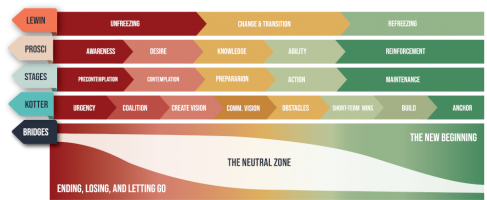
(At the bottom of the diagram), VIDEO: William Bridges describes a “Neutral Zone” between Ending, Losing, and Letting Go on the way to a New Beginning.
VIDEO: Kurt Lewin describes three stages to conceptualize broad categories of the change process:
- Unfreeze -> Change and Transition -> Refreezing
-
John Kotter, former Harvard Business School professor is the authority on change. @JohnPKotter
- “The Evolution of the 21st Centry Organization”
- Transition case studies
- Kotter’s 8 Step Model case study
VIDEO: BOOK: Kotter’s 8-step model first published in the Harvard Business Review advises:
-
Create Climate for Change:
1). Create Urgency
2). Build a Coalition
3). Create a Vision -
Engage and Enable the Organization:
4). Communicate that Vision
5). Empower Others to overcome Obstacles
6). Create Short-Term Quick Gains -
Implement & Sustain:
7). Build on the Change
8). Embed (Anchor) the Change
-
There are 3 phases in the Prosci Process for organizational change:
- Prepare Approach - deliverable Change Management Strategy establishes the approach needed to deliver desired project outcomes.
- Define Success - What are we trying to achieve
- Define Impact - Who has to do their jobs differently and how?
- Define Approach - What will it take to achieve success?
- Manage Change - deliverable Master Change Management Plan consolidates individual plans and serves as the guiding document for the change management team.
- Plan and Act - What wil we do to prepare, eqipt, and support people?
- Track Performance - How are we doing?
- Adapt Actions - What adjustments do we need to make?
- Sustain Outcomes - the deliverable Change Management Closeout documents the change performance status, plus prepares the organization to own and sustain change outcomes.
- Review Performance - Where are we? Are we done yet?
- Activate Sustainment - What is needed to ensure the change sticks?
- Transfer Ownership - Who will assume ownership and sustain outcomes?
- Prepare Approach - deliverable Change Management Strategy establishes the approach needed to deliver desired project outcomes.
Prosci
Prosci (general inquiry 970-203-9332)
BOOK: VIDEO: ADKAR model for individual change developed in the 90s by Prosci founder Jeff Hiatt after studying the change patterns of more than 700 organizations. Here is a common volcabulary for describing what each individual needs to successfully adopt each change.
Where an individual’s journey can get blocked if not achieved in this specific sequence:
-
Awareness of the need for change (not just that change is happening)
-
Desire to participate and support the change - the personal choice to get onboard
-
Knowledge about how to change (through training and coaching)
-
Ability to implement desired skills and behaviors (adopt and change through practice)
-
Reinforcement to sustain the change (through evaluation, correction, celebrations)
VIDEO: When we identify where each stakeholder stands and act accordingly, we don’t waste time and resources rehashing what the stakeholder has already passed, or getting ahead of that person.
ADKAR resources:
- VIDEO from the Agile Transformation course within the 5-course Agile Leadership Specialization on Coursera
- ADKAR checklist
- How to take ADKAR from theory to practice
- ADKAR personal transformation form
GROW model for mentoring and coaching:
- Goal
- Reality
- Opportunity
- Way Forward
Stages:
- In precontemplation, the individual is completely unwilling to consider a change.
- During contemplation, actors are planning for change - how do you setup the right systems to increase the chances of success.
- Preparation to address need for change.
- Action against previous holding things in one’s hands.
- Maintenance.
Attendance at Prosci’s class includes a 1-year subscription to their Practitioner eToolkit which contains PowerPoint, Word, and Excel templates for most of the Prosci tools.
McKinsey’s 7S Change Model
Developed by McKinsey consultants Robert Waterman and Tom Peters during the early 1980s, the McKinsey 7S model refers to seven key interrelated or integrated elements of an organization, all starting with the letter S.
The 7 are subdivided into hard and soft elements:
“Hard” elements are within the direct control of management because they can be easily defined and identified:
1) Strategy: the plan of action, roadmap, or blueprint for an organization to gain a competitive advantage or leadership edge.
2) Structure: the organizational structure of who reports to whom.
3) Systems: the day-to-day activities to get tasks get done – procedures and tools to ensure completion of tasks.
“Soft” elements are less tangible and are difficult to define as they are more governed by the culture, but also important to an organization’s success and growth.
1) Style: leadership behaviors, which influences strategic decisions, people motivation, and organizational performance.
2) Staff: The general staff or the capabilities of the employees
3) Skills: competencies of employees which play a vital role toward organizational success.
4) Shared Values: The core values (superordinate goals) which get reflected within the organizational culture or influence the code of ethics.
Shared values are at the center of the model because it influences all the other elements of the model which are interconnected and interrelated.
The 7S model provides elements of a strategic plan of action for reaching from the current state to the desired organizational state:
-
Identification of inconsistencies or gaps between various framework elements which do not align.
-
Organizational design for optimal fit, which will be different for different organizations.
-
Deciding the course of actions or the changes which are required to be implemented.
-
Actual implementation of the change and the final stage or the fifth stage is the final review of the 7S framework.
Criticisms of the 7s model include:
- Lack of enough empirical evidences to support explanations.
- It is rather difficult to assess the degree of fit with accuracy.
- The model does not explain the concept of organizational effectiveness or performance explicitly.
- It ignores the importance of the external environment and depicts only the most crucial elements in this model for explaining the interdependence of the key processes and factors within the organization.
- It misses the intricate or finer areas in which actual gaps in conceptualization and execution of strategy may arise.
- The model is considered to a static type of model, rather than dynamic over time.
Scott Mautz
Vest-wearing inspirational speaker and author of book “Leading from the Middle” and newsletter Scott Mautz, in his 13-hour video course [LinkedIn subscription] has us remember that:
Questions before implementing change:
- Clear on problem you’re solving?
- Avoiding change drift?
- Clear vision for change?
- Changes in policies, processes, jobs?
- Owners of the change?
- Measure success?
“Temperature check”:
- The Skill
- The Will
- The Hill (barriers to overcome)
Enthusiasm Blockers:
- Skepticism
- Undercommunicating the change vision
- Misinformation, rumors, fear
- Structures or systems that work against change - make the old ways unavailable. Help employees become skilled at the new ways faster
- Change fatigue
Define change in a BEST Guide (basis to assess, anticipate, overcome barriers):
- Behaviors
- Expectations
- Skills required
- Training
Managers get commitment from workers who feel:
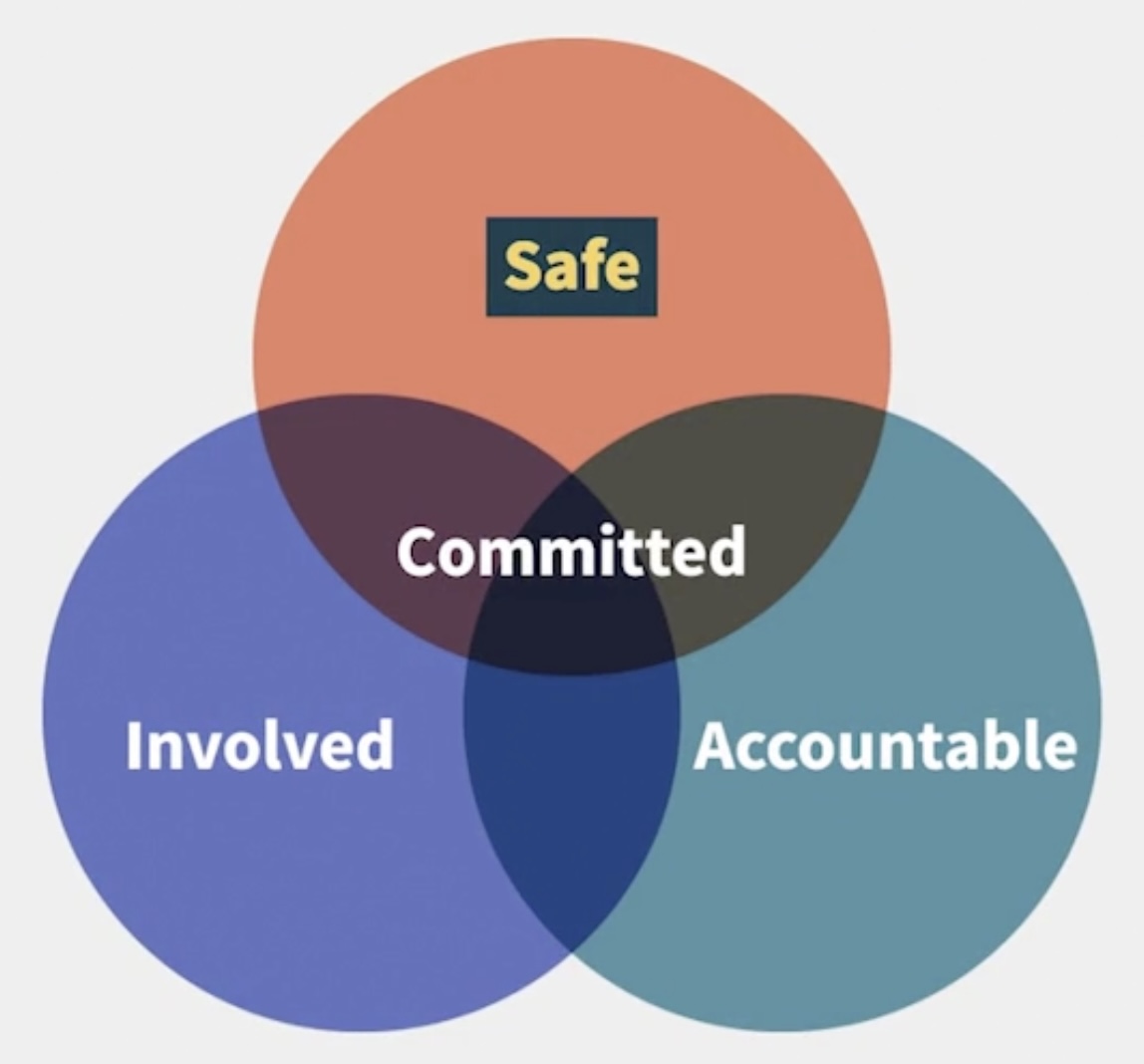
- Safe
- Involved
- Accountable
“Excited urgency” is inspiring employees to take action based on enthusiasm for the end state more than based on fear of repercussions.
Offering support:
- Empathetic words
- Stories of your own change experience
- Access to change leaders
- Tangible support -> training
OCM Influencers
PROTIP: Follow these on LinkedIn, Twitter:
-
Adam Grant, Professor of Organizational Psychology at Wharton School of Business in Pennsylvania. @AdamMGrant
-
Tim Creasey, Chief Innovation Officer at Prosci. @timcreasey has benchmarking studies.
-
Nick Tealser, @NickTasker
-
Yvonne Ruke Akpoveta, Change Leadership Advocate, Speaker - @YvonneRAkpoveta
-
Carsten Tams, Consultant & Blogger (on Forbes) @Carsten_tams
-
Barbara Tautlein, PhD, @brautlein
-
Mark Murphy (of LeadershipIQ.com) writes in Forbes magazine
Social groups
Consultancies
- https://www.ibm.com/downloads/cas/YPAPB0A2
- https://www.accenture.com/nl-en/blogs/insights/mappe-model-for-transformation
- https://www.accenture.com/us-en/services/talent-organization/change-management
-
https://www.accenture.com/ie-en/case-studies/about/it-change-adoption
- https://www.bain.com/consulting-services/change-management-results-delivery/
Summary
[2] Machiavelli directly addresses three core principles of successful change management:
1) Change is a process – Change is NOT just an announcement or an event, it is a process. It is difficult for people to put their faith in something that they have not experienced. This is why it is critical to have active and visible sponsorship throughout the change. More than one change has found itself floundering because the sponsors observed substantial progress and moved on to the next issue, trusting in ‘momentum’ to carry it the rest of the way. The reality is that as soon as the sponsors lose visibility, the momentum shifts to the defenders of the old way and hard-earned gains are soon lost.
2) Expect resistance – Major change alters power structures, shifts responsibilities, and crosses organizational boundaries, which affects real people with real influence. These real people get their real influence from the existing power structures, responsibilities, and organizational roles. Therefore, it is dangerous to underestimate the power of the desire to hold onto the current state. Machiavelli provided this observation as a reminder that people tend to work in their own self-interest and that the fear of losing something is generally stronger than the hope of gaining something. In other words, don’t waste energy wondering why people are resisting and focus your efforts on leading through the resistance.
3) Build support
Thus, effective leadership is critical to successful change and requires active sponsorship throughout the change, expecting and managing resistance, and building support.
Certifications about change mangement
There are several out there.
https://www.cio.com/article/3276004/7-change-management-certifications-to-boost-your-it-career.html
President of ACMP Roxanne Brown of Change Decision says VIDEO: A certification is for attending a class. The CCMP designation is obtained after class and passing an exam based on an industry-standard of terminology, but also demonstrated flexibility.
Certifications specifically about change mangement
Listed from cheapest to most expensive/prestigeous:
-
$213 Certified Problem and Change Manager (CPCM) by the Global Association for Quality Management (GAQM), focuses specifically on identifying and fixing problems in an organization - those working with development processes or overseeing product life cycles. It covers identifying areas for change, implementing that change, encouraging employee buy-in, and creating resilient strategies. It’s based on EU’s e-Competency Framework organized around macro processes PLAN – BUILD – RUN – ENABLE – MANAGE.
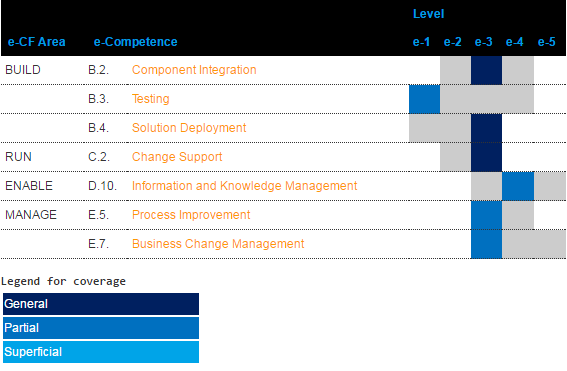
Pass 70% of 40 questions in 1 hour online by ProctorU. Closed book. Valid for life.
-
$245 DevOps Leader (DOL) for a transformational leadership approach to make an impact within their organization by implementing DevOps. Answer 65% of 40 multiple-choice questions in an hour, online, with open book. Leading people through a DevOps evolution requires new skills, tools, innovative thinking, and transformational leadership. Leaders up, down and across an organization must align and collaborate to break down silos and evolve the organization. The exam and course highlights the human dynamics of cultural change and equips participants with practices, methods, and tools to engage people across the DevOps spectrum, such as Value Stream Mapping. Topics include:
- DevOps and time to value
- Mindset and mental models
- Key differences between DevOps IT and traditional IT
- Target operating models and organizational design
- Performance management, rewards and motivation
- Preparing investment cases
- Focusing on value outcomes
- Ideas for organizing workflows
- Empowerment and participation
- Defining meaningful metrics
- Value stream mapping
- Driving cultural and behavioral change
-
$300 Change Management Specialist (CMS) from MSI (Management and Strategy Institute) is 2-hour online. Fee includes self-paced online training materials that covers basic change management principles.
-
$340 Organizational Change Management Foundation (among other certifications administered by APGM-International based in London, UK), which has 45,822 followers on their LinkedIn page.
-
$390 Certified Local Change Agent (CCLA) is administered by APGM for leaders and staff after a 2-day class. Open book pass 50% of 40 questions over 45 minutes.
The exam covers approaches to helping others engage with organizational change, aligning changes with departmental or organizational changes, developing change plans, and creating relationships between change professionals in the organization.
### CCMP from ACMP
-
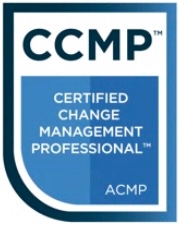 $595 for the CCMP (Certified Change Manager) by the Association of Change Management Professions (ACMP) based on ACMP’s 64-page Standard for Change Management© VIDEO: first released in 2014.
$595 for the CCMP (Certified Change Manager) by the Association of Change Management Professions (ACMP) based on ACMP’s 64-page Standard for Change Management© VIDEO: first released in 2014.The exam is 150 questions online over 3 hours. The passing percentage of correct answers is not published, nor are what score each candidate received.
Their PDF: Candidate Handbook, requires write of an essay for 3 of these 5 domains on their website:
-
For a project completed in the last two years, discuss how your assessment of the history, culture, and value systems of an organization helped the employees through a change process and has impacted employee expectations about change management plans and activities during that change project, today, and into the future.
-
How did you address the readiness strategy in your last change project? What would you change if you could go back in time, to ensure a smoother transition during change?
-
Describe specific actions you have taken to measure and assess the effectiveness of a Learning & Development Plan. Include major challenges you encountered and how you dealt with them.
-
Describe a situation where you needed to modify the Change Management Plan during the execution phase and include the circumstances leading to the modifications and to the end results. Clearly identify if new items were added, if current items were eliminated, altered, or realigned in response to internal or external pressures.
-
Describe two major lessons learned from Change Management projects/processes that you have been involved in and explain how you included these lessons into current change projects going forward.
As of this writing Nov 2022, there were 1,525 CCMPs.
To meet the 21 hours of live instructor-led instruction (before registering for the exam):
- Roger Watson at jtask.com conducts on-line over 4 fridays 8-2pm PT. for $880 ($780 for ACMP members). Free retakes and valid for 7 years. Included in the fee is a physical deck of cards to help you memorize the process items. (I took this in Nov 2022 and found it excellent).
- $799 Acuity Institute - 3 months of online course access virtual simulation. The company also does Six Sigma and Lean training.
- Confident Change Management
- Prosci
- ChangeIt
PDF: Certification Path Explained
Chapter 5 of ACMP’s Standard ACMP’s Standard consists of 31 processes organized into 5 process groups:
Group Processses 1. Evaluate Change Impact & Organizational Readiness 15 2. Formulate the Change Management Strategy 7 3. Develop the Change Management Plan 4 4. Evaluate the Change Management Plan 2 5. Complete the Change Management Effort 3 The Standard defines the inputs and outputs of each process for these strategies and plans:
- Resource Plan (no Strategy)
- Communication
- Sponsorship
- Stakeholder Engagement
- Change Impact and Readiness Strategy (no Plan)
- Learning and Development
- Measurement and Benefit Realization
- Sustainability
ACMP provides its own certification verification/lookup page.
-
-
A $1,050 Master level accreditation is for “highly experienced, senior change practitioners to stand out from their peers as leaders in the profession,” and is best suited for those with more than 7 years’ experience.
-
The $675 Specialist level requires 3-6 years of experience operating at the project or program level as evidenced by a written assessment that provides evidence of your skills, backed up with references from those who have observed your abilities, and you’ll need to complete a virtual interview with an independent assessor.
-
The $575 foundation level (discounted to $450 with CMI-endorsed training at Prosi or APMG) based on the Change Management Body of Knowledge (CMBoK).
The two above are from the 3-levels described in the PDF: Accreditation Handbook for Change Management Institute Certification (CMI) based on a privately-owned Australian institute’s Change Manager Competency Model and Body of Knowledge (CMBoK) by the Change Management Institute who wrote the The Effective Change Manager book and Change Management Body of Knowledge (CMBoK).
Their exam’s focus include: motivating employees, engaging stakeholders, assembling teams, and delivering on effective change strategies.
-
$1,495 for members of The Association for Talent Development (ATD) for the ATD Change Management Certificate trains HR/learning professionals on how to improve efficiency, productivity, and service quality. The (six-session over 12 hours, online or 2 days in person) covers: implementing change processes, change management tools, qualities of a change leader, and how to encourage the organization to embrace change. Learn how to conduct diagnostic assessments, define change efforts, analyze data, provide feedback, understand change management theories, select the right change model, create implementation designs, develop communication plans, and manage any consequences of change.
-
$2,999 for 11 hours of video online from Rob Bogue’s confidentchangemanagement.com explains the shortcoming of the ACMP Standard:
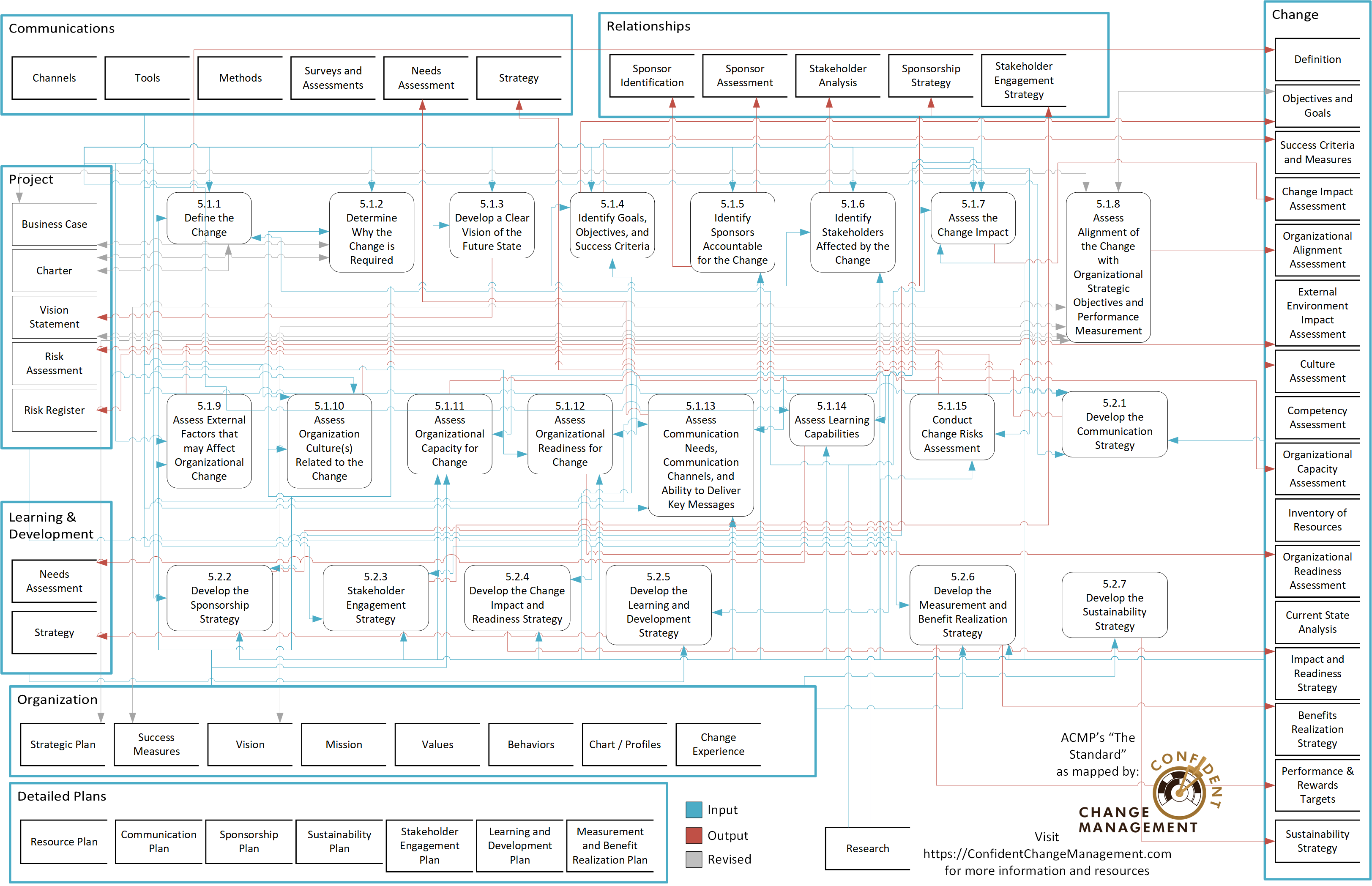 [3:05] “The Standard is … broader in structure than most models. While the Standard is more detailed than most models, it doesn’t appear to help practitioners know what to do.”
[3:05] “The Standard is … broader in structure than most models. While the Standard is more detailed than most models, it doesn’t appear to help practitioners know what to do.”[3:47] “The Standard model is completely process-focused and therefore ignores the skill of the practitioner. Other than development of strategies for communication, stakeholders, and learning, the Standard is quiet in terms of how to motivate stakeholders to want to do the change. This is curious since most of the effort in a change project is developing the desire the change. However, this gets minimal attention in the Standard. Ultimately, the Standard is a tool to understand the project management aspects of change, with minimal support for the people aspects of change.”
-
$3,100 AIM Change Management Professional certification is obtained after a 3-day training (virtual or on-site) by consultant Don Harrison. “it’s a day longer than most, because there is so much to know — including how to manage leaders and how to deal with the power and politics of change”. AIM focuses on the human side of risk; rather than look at how technology or software fails us, it encourages leaders to strengthen processes that involve employees, given that human-error is one of the biggest risks for failure. The certification is targeted at human resources, organizational development, IT, and business and clinical leaders, as well as project managers.
-
$4,850 for 3-days on-site or $4,500 virtually to learn their ADKAR models. The Prosci Certified Change Practioner certification
- https://www.youtube.com/watch?v=oMiI59NMO2Q
Certifications with a change management component:
-
$405 Project Management Professional (PMP) (for PMI members)
https://www.cio.com/article/228204/pmp-project-management-certification-guide.html
https://jtask.com/app/uploads/2020/09/task-pmp-eco.pdf
-
$3,100 ITIL4 Foundation from Axelos includes a “Service Management” category.
The ACMP Standard
Under ACMP, professionals around the world collaborated in an extensive Practice Analysis Study of leading practices in change management and ended up with The 2019 Edition of the 79-page Standard defines best practices and ethics in change management. It references ISO 21500:2012(E) Guidance on project management.
In The Standard, there are 23 steps organized into:
-
Evaluate Change Impact and Organizational Readiness - The processes in this group assess, evaluate, and anticipate an organization and its stakeholders’ readiness, ability, and capacity to undergo a transition from the current state to a future state. The processes also include an assessment of the change and the impact the change will have on the individual and organization. History, culture, and value systems play key roles in these evaluations. The results provide change practitioners with information to calibrate leader expectations and to scale and customize change management plans and activities.
-
Formulate the Change Management Strategy - The processes in this group develop the high-level approach for change management with sponsors, change leaders, content developers, program managers, customers, and others on the project. This approach includes governance, risks, resources, budget, and reporting. The change strategy will incorporate, integrate, and align change management plans, activities, tasks, and milestones into the other activities and operations of an organization and its stakeholders at the onset of a change (timing and sequence). Stakeholder engagement is included in this process group.
-
Develop the Change Management Plan - The processes in this group employ specific change management methodologies and tools to develop detailed plans for implementing the change management strategy. These plans include communications, sponsorship, stakeholder engagement, learning and development, risk management, and measurement and benefits realization. Ongoing integration with project management is included in this process group.
-
Execute the Change Management Plan - The processes in this group focus on the implementation of work/actions in the detailed change management plans. The work in this area is required to achieve the expected benefits of the change management implementation.
-
Complete the Change Management Effort - The processes in this group reinforce the work in the change management plans, determine the effectiveness of the work, monitor progress, and transition the change initiative to the business. These processes include measuring results and comparing to the expected benefits or business objectives. These processes also include the continuous improvement activities that come from the post-project analysis and lessons learned.
Within “Evaluate Change Impact and Organizational Readiness”:
| Memonic | Section 5.1... |
|---|---|
| D |
1 Define the Change 2 Determine Why the Change is Required 3 Develop a Clear Vision of the Future State |
| I |
4 Identify Goals, Objectives and Success Criteria 5 Identify Sponsors Accountable for the Change 6 Identify Stakeholders Affected by the Change |
| A |
7 Assess the Change Impact 8 Assess Alignment of the Change with Organizational Strategic Objectives and Performance Measurement 9 Assess External Factors that may Affect Organizational Change |
| C |
10 Assess Organization Culture(s) Related to the Change 11 Assess Organizational Capacity for Change 12 Assess Organizational Readiness for Change 13 Assess Communication Needs, Communication Channels and Ability to Deliver Key Messages 14 Assess Learning Capabilities 15 Conduct Change Risks Assessment |
References
[1] https://www.lce.com/Niccolo-Machiavelli-Change-Agent-1272.html
[2] https://www.linkedin.com/pulse/machiavelli-change-innovation-guido-stroemer/
[3] https://www.cio.com/article/221699/7-change-management-certifications-to-boost-your-it-career.html
[4] VIDEO: Organizational Change Management Training 3 Hr class by Eric Kimberling
[5] https://www.youtube.com/watch?v=feK9hkJ9p2E DevOps and the Future of Change Management - YouTube
[6] https://www.inc.com/marcel-schwantes/5-things-the-most-confident-leaders-do-to-manage-change.html
[7] https://blog.doculabs.com/focus-on-objectives-when-capturing-ccm-metrics
https://www.credly.com/org/association-of-change-management-professionals/badge/certified-change-management-professional-ccmp
https://www.theknowledgeacademy.com/us/courses/change-management-training/certified-change-management-professional-ccmp-/ $1995 request for discount Does a variety of other trainings -
“Certified Change Management Professional (CCMP™)” 10 hour video course on Pluralsight by Alice Meredith and Kevin J. Miller. The course does not qualify as that 21 hours of required training for taking the exam (because ACMP insists on live training, either in-person or live online with the instructor present at the time of training). However, the Pluralsight courses qualify for PDUs once you pass the exam, to keep it current. And the course provides and explains use of templates to use in your job as a change manager or analyst.
Join the ACMP channel on Pluralsight
“Top 10 Change Management Certifications to Complete (2022)
eCornell Change Management Certificate
Strategies for Leading Successful Change Initiatives program at Harvard Extension School for Professional Development.
“When environment are complex and dynamic, strategy is about adaptability” – MIT Sloan magazine Dec 2020, article “The Essence of Strategy Is Now How to Change” by B. Tom Hunsaker, Jonathan Knowles

